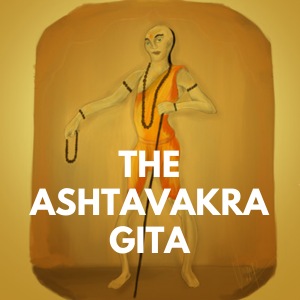The Eternal Wisdom of the Ashtavakra Gita: A Journey Beyond the Bhagavad Gita

The Ashtavakra Gita is one of the most profound spiritual texts in Hindu philosophy. It offers deep insights into self-realization, consciousness, and liberation, focusing on the Advaita (non-duality) philosophy. Unlike the Bhagavad Gita, which is set on a battlefield, the Ashtavakra Gita takes place in the court of King Janaka, making it a purely philosophical and introspective dialogue.
The beauty of this scripture lies in its radical simplicity. It does not prescribe rituals, sacrifices, or elaborate moral codes. Instead, it points directly toward the essence of one’s existence—pure awareness. This makes the Ashtavakra Gita a powerful text for those seeking enlightenment beyond conventional religious doctrines.
What is Ashtavakra Gita?
The Ashtavakra Gita is a sacred dialogue between Sage Ashtavakra and King Janaka. This ancient dialogue, brimming with paradoxical wisdom, challenges conventional thinking and offers a unique perspective on the illusory nature of the self. It is a scripture that transcends rituals, religious dogma, and moral constructs, leading one directly to self-awareness and absolute freedom. It teaches that liberation (Moksha) is not something to be achieved but something that already exists within us.
Unlike other spiritual texts, which often mix devotion, duties, and ethics, the Ashtavakra Gita is pure philosophy. It declares that you are already free, infinite, and beyond suffering—you just need to realize it.
The Story of Ashtavakra
Ashtavakra, the central figure of the Ashtavakra Gita, was a great sage known for his wisdom and spiritual insight. His name, “Ashtavakra,” means “eight bends,” referring to the eight physical deformities he had from birth. Despite his physical appearance, Ashtavakra was a prodigious scholar and philosopher.
The story unfolds as a captivating discourse between Ashtavakra, the embodiment of effortless wisdom, and his father, a learned scholar grappling with complex philosophical questions. Kahoda, despite his extensive knowledge, finds himself entangled in the complexities of Vedic scriptures and struggles to reconcile them with his own experiences. Ashtavakra, with his intuitive understanding of reality, guides his father through the labyrinth of philosophical dilemmas, unraveling the mysteries of consciousness and the illusion of separation.
The Encounter with King Janaka
As a young sage, Ashtavakra visited the court of King Janaka, a wise and enlightened ruler. Despite being mocked for his physical appearance, Ashtavakra’s wisdom silenced the court scholars and amazed the king.
The young sage saw that the so-called wise men in the king’s court were merely intellectual debaters with no direct experience of truth. His fearless approach challenged the very foundations of their knowledge.
Ashtavakra’s Wisdom and Enlightenment
King Janaka, recognizing Ashtavakra’s wisdom, became his disciple. Their conversation became the foundation of the Ashtavakra Gita, where the sage imparted knowledge on self-awareness, detachment, and the illusion of worldly existence.
The 5 Principles of Ashtavakra Gita:
The Ashtavakra Gita, though concise, encapsulates profound philosophical principles that challenge conventional understanding:
- The Illusory Nature of the Self: The core message of the Ashtavakra Gita revolves around the illusory nature of the individual self. It emphasizes that the perceived “I” is a mere projection of consciousness, a fleeting shadow constantly changing and evolving. True liberation lies in recognizing the non-existence of this limited, individual self.
- The Unity of Consciousness: There is no distinction between you and the universe. Everything is one. The Gita asserts the fundamental oneness of all beings. It emphasizes that consciousness is the underlying reality, a single, indivisible field that permeates the entire universe. Individuality is merely an illusion, a temporary manifestation of this universal consciousness.
- The Power of Presence: The Ashtavakra Gita highlights the importance of being present in the “now.” It emphasizes that dwelling in the past or worrying about the future creates unnecessary suffering. By cultivating mindfulness and remaining present in the moment, one can experience true freedom and joy.
- The Paradox of Non-Doing: The Gita advocates for effortless action, emphasizing that true action arises from a state of non-attachment and non-striving. It encourages individuals to act without any personal agenda, surrendering to the flow of life and allowing their actions to unfold naturally.
- The Path of Inquiry: The Ashtavakra Gita emphasizes the importance of self-inquiry as the path to liberation. It encourages individuals to question their assumptions about reality, to delve deep within themselves, and to directly experience the truth of their own being.
The Teachings of Ashtavakra Gita
The Ashtavakra Gita offers a wealth of profound teachings that resonate with seekers of truth:
- Beyond the Mind: Your true nature is beyond the body and mind. You are pure consciousness, limitless and free. The Gita transcends the limitations of the intellect, urging individuals to go beyond the realm of thought and experience reality directly. It emphasizes that true knowledge arises from intuitive understanding and direct experience, not from intellectual speculation.
- The Dance of Contradictions: There is no absolute right or wrong. One must transcend all dualities to realize their true self. The Gita embraces the paradoxical nature of reality, acknowledging that seemingly contradictory truths can coexist. It encourages individuals to embrace the dance of opposites, recognizing that every experience contains within it its own opposite.
- The Art of Letting Go: The world is an illusion (Maya). Happiness and sorrow are mere experiences that come and go. The Gita emphasizes the importance of detachment and non-attachment. It encourages individuals to let go of their desires, fears, and expectations, freeing themselves from the bondage of the ego.
- The Joy of Being: The Gita emphasizes the inherent joy of existence. It encourages individuals to cultivate a sense of gratitude and appreciation for the present moment, recognizing the beauty and wonder of life.
- The Transience of the World: The Ashtavakra Gita teaches that the material world is transient and impermanent. By recognizing the impermanent nature of worldly possessions and desires, one can cultivate detachment and inner peace. A person who realizes the truth is free from fear, attachment, and suffering.
- The Power of Inner Silence: The Gita emphasizes the importance of inner silence and meditation in attaining self-realization. By quieting the mind and turning inward, one can connect with their true nature and experience inner peace.
Ashtavakra Gita vs. Bhagavad Gita
While both the Ashtavakra Gita and the Bhagavad Gita offer profound insights into the nature of reality and the path to liberation, they differ in their emphasis and approach:
- Focus: The Bhagavad Gita primarily focuses on the path of duty (dharma) and the importance of selfless action. It emphasizes the importance of fulfilling one’s responsibilities in the world while remaining detached from the fruits of one’s actions. The Ashtavakra Gita, on the other hand, primarily focuses on the nature of consciousness and the illusory nature of the self. It emphasizes the importance of self-inquiry and the direct experience of reality.
- Tone: The Bhagavad Gita, while profound, often presents its teachings in a more didactic and authoritative tone. The Ashtavakra Gita, in contrast, offers its wisdom in a more playful and paradoxical manner, challenging the listener to question their assumptions and delve deeper into the nature of reality.
- Emphasis on Action: While both texts acknowledge the importance of action, the Bhagavad Gita places greater emphasis on the importance of performing one’s duties in the world. The Ashtavakra Gita, while not negating the importance of action, emphasizes the importance of effortless action that arises from a state of non-attachment and non-striving.
Importance of Ashtavakra Gita and Bhagavad Gita in Sanatan Dharma
The Ashtavakra Gita and the Bhagavad Gita are both considered to be foundational texts in Sanatan Dharma. They offer profound insights into the nature of reality, the human condition, and the path to liberation. These texts have inspired countless individuals throughout the centuries, providing guidance and solace in the face of life’s challenges.
- Guiding Principles: Both texts provide a framework for ethical living and offer guidance on how to navigate the complexities of life. They emphasize the importance of compassion, selflessness, and living in harmony with oneself and the world.
- Spiritual Growth: Both texts offer profound insights into the nature of consciousness and the path to spiritual growth. They encourage individuals to go beyond the limitations of the ego and experience the true nature of reality.
- Personal Transformation: Both texts can be powerful tools for personal transformation. By studying and reflecting on the teachings of these texts, individuals can gain deeper insights into themselves and cultivate greater self-awareness, compassion, and inner peace.
Practical Meditation Techniques Based on Ashtavakra Gita
- Witness Consciousness – Observe thoughts without attachment.
- Non-Dual Awareness – Meditate on the idea that you are one with existence.
- Letting Go of Identification – Release attachment to personal identity and stories.
Stories and Anecdotes Illustrating the Teachings
- The Mirror and the Self – How true nature is like a reflection in a mirror, unchanged by external events.
- The Ocean and the Wave – How individual existence is like a wave in the vast ocean of consciousness.
Misconceptions About Ashtavakra Gita
- It rejects moral values – It does not reject morality but transcends dualities.
- It is for renunciates only – Even householders can benefit from its wisdom.
Conclusion
The Ashtavakra Gita, with its enigmatic wisdom and paradoxical teachings, offers a unique and challenging perspective on the nature of reality. It invites readers to question their assumptions, to go beyond the limitations of the mind, and to experience the truth of their own being. While the Bhagavad Gita provides a comprehensive framework for living a meaningful and purposeful life, the Ashtavakra Gita delves deeper into the mysteries of consciousness, offering profound insights into the nature of the self and the path to liberation.
Both texts, in their own unique ways, offer timeless wisdom that can inspire and transform lives. By studying and reflecting on the teachings of these profound scriptures, individuals can gain deeper insights into themselves and the world around them, cultivating greater self-awareness, compassion, and inner peace.
Note: This blog post provides a general overview of the Ashtavakra Gita and its key teachings. It is important to note that the interpretations and understandings of these ancient texts can vary greatly.
Disclaimer: This blog post is intended for informational purposes only and should not be considered a substitute for professional guidance.
Further Exploration:
- Read the Ashtavakra Gita: Many translations and commentaries of the Ashtavakra Gita are available.
- Study the Bhagavad Gita: Explore the profound wisdom of the Bhagavad Gita and its relevance in contemporary life.
- Engage in Self-Inquiry: Practice meditation, mindfulness, and other contemplative practices to deepen your understanding of yourself and the nature of reality.
- Join a Study Group: Connect with others who are interested in exploring the teachings of the Ashtavakra Gita and engage in meaningful discussions.
I hope this blog post provides a valuable introduction to the profound wisdom of the Ashtavakra Gita. May you find inspiration and guidance on your journey of self-discovery.
FAQs
- What is the main message of the Ashtavakra Gita?
The main message is that you are already free and divine; liberation is about realizing this truth.
- Can a beginner read Ashtavakra Gita?
Yes! Unlike other scriptures, it is short, direct, and free from complex rituals.
- How does Ashtavakra Gita differ from Bhagavad Gita?
It focuses solely on self-realization and non-duality, unlike the Bhagavad Gita, which covers duty, devotion, and ethics.
- Is Ashtavakra Gita suitable for modern life?
Absolutely! Its principles help in reducing stress, achieving mental clarity, and understanding the impermanence of life.
- Where can I read the Ashtavakra Gita?
It is available online and in bookstores. Some translations offer easy explanations for better understanding.


1 thought on “The Eternal Wisdom of the Ashtavakra Gita: A Journey Beyond the Bhagavad Gita”
Comments are closed.